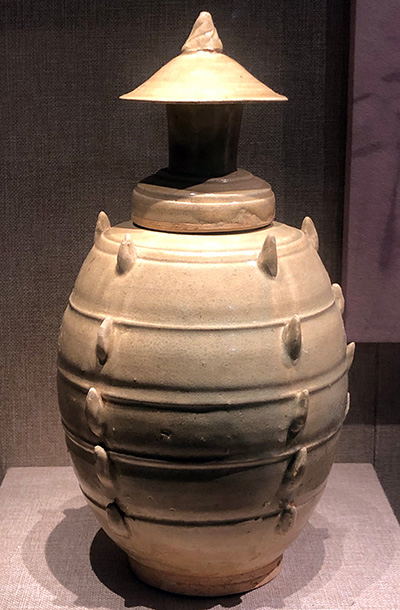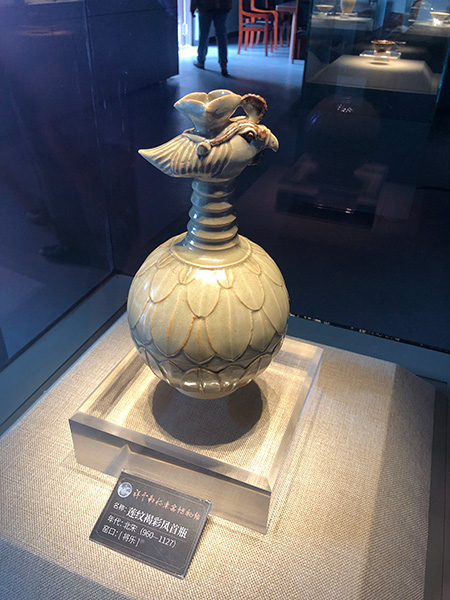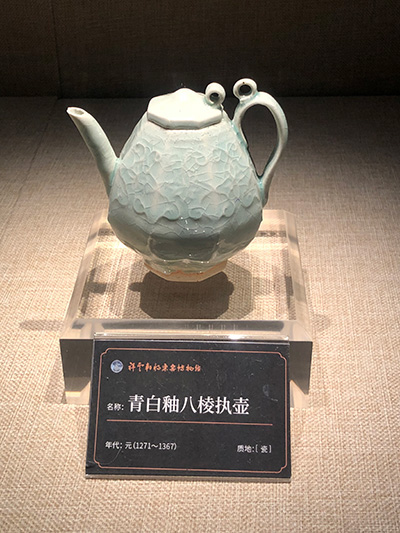
Yu Xueyun appreciates a Jiangle porcelain piece at his home in Jiangle county, Fujian province.[Photo provided to China Daily]
Until December, Yu Xueyun, a collector of antique porcelain pieces in Sanming, Fujian province, donated more than 1,500 selected items to public museums in hopes that the art can be better protected.
In the past 30 years, Yu, 50, spent about 30 million yuan ($4.6 million) in porcelain ware, all of which belong to the Jiangle type of ceramics, named after its producing place, Jiangle county in Sanming city.
Yu made the donations because he said he wanted to hand down the Jiangle porcelain culture and the government has more resources to promote it.
He said Jiangle porcelain ware originated more than 3,000 years ago because the place had abundant rich soil.
Kilns in Jiangle started to flourish in the Song Dynasty (960-1279).
The key characteristics of Jiangle porcelain are its solid soil body, glassy glaze, smooth tactile surface, a bluish-white color and low-key yet delicate patterns printed on bowls, teapots and plates.
"Such cultural relics are a crystallization of ancient wisdom. They should not be just personal ornaments behind closed doors," Yu said.
He began to collect the old items as a boy but later put all his income and savings into protecting and researching them.

Yu recalled that he first had the idea of collecting porcelain pieces at the age of 12 when he happened to find a small dish with two butterflies painted on it near a construction site on his way home from school.
"I picked it up just because it was lifelike but never thought it was identified by some expert in our village as a porcelain ware dating back to the Qing Dynasty (1644-1911)," Yu said.
From then on, he began to pay more attention to old porcelain in the soil around his village in Jiangle county.
"At that time, people treated antiques as something of a taboo because ancient people who died had used them. Therefore, few people cared about the porcelain and wouldn't collect such items," he added.
Yu quit school at 16 due to the lack of financial support from his farmer parents and made a living by doing odd jobs, including planting crops and repairing watches.
In 2000, he opened a hotel while carrying on with his collection hobby. He bought things from antique markets in the province and resold some that appreciated in price.

After years of collecting, Yu gradually realized that porcelain produced in Jiangle was both unique and delicate.
He said of that time: "Why not focus on collecting and researching Jiangle porcelain since I am a local and have every reason to do so?"
Since then, he would keep just Jiangle porcelain and use the money from selling other antiques to collect more such ware produced in his hometown.
In 2010, Yu removed a wall between a room that he had rented from his neighbor and combined it with his own room and renovated the space into a 150-square-meter family museum that opened to the public for free.
Since 1990, he has donated from his classic Jiangle porcelain collection to the county and Sanming city museums.
"My family opposed my donation drive because the porcelain cost us lots of money. But I thought such artistic pieces handed down from our ancestors should be shared with others. Besides, the government is a more reliable curator that can also better promote the Jiangle porcelain culture," Yu said.
In May, the county government established a museum and assigned Yu as the curator.

Now, Yu displays all his remaining antiques in the museum, which has become a first specifically for Jiangle porcelain.
Yu Leixi, the older of his two daughters, said her father had never bought any luxury items but put all the money in porcelain. At first she couldn't understand why her father used up his money in such a hobby. But as she grew up, she said she learned a lot from her father.
"Although my father didn't receive higher education, his life philosophy and insight into things go beyond those of some people even with a degree. His concentration on his hobby has made him a man with integrity. He has donated lots of precious porcelain to be shared with the public," she said.
The 29-year-old is following in her father's footsteps by studying heritage and museology for her master's degree from Shandong University in Jinan.
She is working on a dissertation about Jiangle porcelain while helping her father plan exhibitions across the country.
So far, they have displayed their collections in Peking University in Beijing, Xiamen City Museum in Fujian and West Taihu Lake Art Center in Changzhou, Jiangsu province.
"I haven't decided where to find a job but it would be related to Jiangle porcelain. It is such a rare culture that it should travel beyond the province to the rest of the country and the world."